Printing Piezoceramics
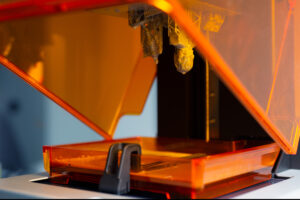
Stereolithography 3D printer using photopolymer resin.
In a not-so-distant future, 3D printing of piezoceramic components may turn out to be much more than just an industry pipe dream. Recently, PhD students at the Technical University of Denmark have been challenging the limitations of current printing technology – by among other things, attempting to print functional piezoceramic geometries provided by Ferroperm Piezoceramics.
By Malte Aarenstrup Launbjerg
Additive manufacturing (AM), popularly referred to as 3D printing, is rapidly changing the landscape of otherwise well-established manufacturing industries. From construction to fashion, medtech to aerospace, businesses across a wide spectrum are bending backwards trying to find new ways of implementing the disruptive technology that holds the promise of a cheaper, faster and more efficient manufacturing process.
Within the field of piezoceramics, the vast potential of 3D printing has not gone unnoticed either. Since the technology first emerged, Ferroperm Piezoceramics has had its ear to the ground, paying close attention to its explosive development. So, when the company in the spring of 2022 was approached by researchers at the Technical University of Denmark (DTU), asking if it would care to provide a case study for a newly established course on additive manufacturing for PhD students, Ferroperm Piezoceramics did not hesitate to oblige.
“Additive manufacturing is an area which we follow closely at Ferroperm Piezoceramics, and we are always willing to lend a helping hand to academics in our field. It goes without saying that we are very eager to see what the sharpest minds at DTU can do to unfold the full potential of the technology,” Dr. Erling Ringgaard, principal materials scientist at Ferroperm Piezoceramics, says.
Pushing boundaries
Ferroperm Piezoceramics was asked to provide a range of shapes and dimensions of common piezoceramic component geometries – like the hemisphere disc – for the students to 3D print in a potassium sodium niobate (KNN) compound. But how exactly does one go about the additive manufacturing of piezoceramics? Is it even possible? The short answer: Yes. Yes, it is.
“Additive manufacturing spans a great many processes. From filament printing on desktop 3D printers over metal powder melts to photopolymers and many other types of printing methodologies,” Venkata Nadimpalli, tenure-track researcher at DTU, says. He and his colleague, David Bue Pedersen, are coordinating the course, designed to push AM technology to its limits and beyond. Among other challenges, the pair had their sights set on cracking the case of 3D printing piezoceramic components.
“We used what is called a photopolymer – a type of liquid material that in the presence of ultraviolet light gets solidified by a reaction called polymerization. You can control this reaction spatially down to a very small dimension, forming the shape you want,” Venkata Nadimpalli explains. He continues:
“Normally you would use this photopolymer printer to make prototype components made just of photopolymer. But during our course, we tried to load the photopolymer with a piezoceramic powder and then printing it. And what happened was that we got a shape in which the ceramic powder was bound by the photopolymer matrix.”
A method to the manufacture
The photopolymerization AM process (also known as stereolithography) that the PhD students utilized, involves a suspension made of monomers, free-radical photoreactive agents and a dispersant. The suspension is placed in a vat, and as it is subjected to ultraviolet light, the photoinitiator reagents cause independent chains of monomers to bind together – a phenomenon known as cross-linking – resulting in a hardening (curing) of the suspension.
In this case, however, a commercial lead-free KNN piezoceramic powder was added to the photoreactive suspension, amounting to a solid loading of 30 %. Upon exposure to ultraviolet light, the suspension cured and bound the powder into the polymer matrix.
Then, layer by layer, the geometries supplied by Ferroperm Piezoceramics were printed. The individual building layers were approximately 7 μm thick and each received five seconds of UV-light exposure, resulting in them being fully cured and without delamination.
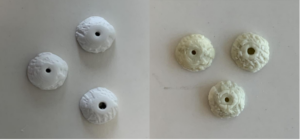
Freshly printed hemisphere discs before and after sintering (work in progress). Photos: Mahmoud Mobin.
Measuring piezoelectric performance
After printing the powder into the photopolymer matrix, the shapes were baked to remove the photopolymer and subsequently sintered, shrinking them and reinforcing their density. The following testing revealed that the sample geometries had achieved an average density of 4.27 g/cm3 – equivalent to 95 % of the theoretical density of KNN ceramics. The geometries showed significant size reduction as a result of the sintering, shrinking 1/3 in the Z axis and 1/4 in the X and Y axes.
Next, the piezoelectric performance of the fabricated parts was tested at DTU Energy’s facilities, and the printed samples proved in fact to be ferroelectric.
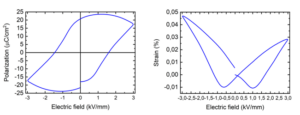
Hysteresis and butterfly loop showing the ferroelectric capabilities of the manufactured shapes. Images: Mahmoud Mobin.
Despite their innate and provable properties, the piezoelectric performance of the printed samples could not compare to industry standards. The samples’ piezoelectric charge coefficients were approximately four times less of what you could expect from industry grade KNN components manufactured the traditional way.
“It is clear that the additive manufacturing of piezoceramics still has a way to go before it can compare and compete with current industrial methods of fabrication. Uniformity in density and geometric precision are key to stable and reliable piezoceramics, and in these areas, the photopolymer technique still needs fine-tuning. But a lot can be achieved by optimizing process parameters and suspension formulation,” Dr. Erling Ringgaard says.
Even though the current printing results fall short of industry standards, he still regards the attempt to additively manufacture piezoceramics as a success.
“Functioning lead-free ferroelectric ceramics with a measurable charge coefficient were produced via additive manufacturing over the course of a mere three weeks. This is by no means a small feat. While the components still are not up to industry par, I think this bodes very well for the future potential of the technology,” he says.
Thinking ahead and outside the box
A major upside to 3D printing piezoceramics is the potential reduction in wasted material. Current methods of manufacturing require the exact and desired geometries to be pressed from ceramic blocks, inevitably resulting in excess material going to waste. Additive manufacturing, however, would allow for direct printing of the desired shapes, bypassing the current loss of material.
“In case of perhaps the most complex standard shape, the hemisphere disc, you still need to take a big block and machine out this geometry. If you can additively manufacture it instead, you will save a lot of material as you can print exactly the shape you need. But it also unlocks a design freedom, granting access to new geometries with potentially even better acoustic properties or mechanical response for instance,” Venkata Nadimpalli says.
Dr. Erling Ringgaard agrees with this sentiment and cites it as one of the main reasons for Ferroperm Piezoceramics to engage in experimental projects like the AM summer school at DTU:
“Very soon, we might just find ourselves in a situation where the capability of the technology exceeds market demand and designer imagination. For this reason, we are actively encouraging our customers and partners to think outside the box and present us with designer tasks and challenges that force us to rethink our approach. A paradigm shift in piezoceramic design and manufacture may be waiting just around the corner. But we will not know for sure until someone goes and takes a thorough look.”
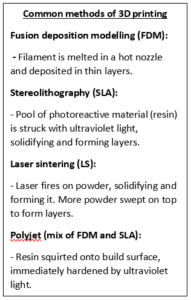
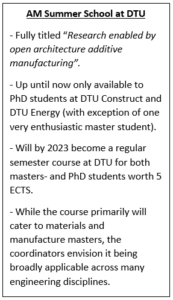
Technical information on the experimental additive manufacturing described in this article was generously made available for the author by M. Mobin, A. Basso, A.H. Danielak, V.K. Nadimpalli, D.B. Pedersen, V. Esposito and A.B. Haugen and paraphrased from ‘’Lithography-based Additive Manufacturing of Alkaline Niobate-based Piezoelectric Ceramics’’, yCAM 2022, Barcelona, Spain. As an ongoing project, the team is currently working on tackling the excessive shrinkage and overcuring of the suspension by modifying the suspension formulation and optimizing of the printing parameters. Their work is supported by a research grant from VILLUM FONDEN.
 ENGLISH
ENGLISH































































